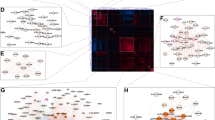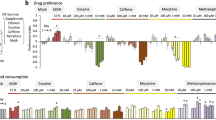Abstract
Animals exhibit behavioral differences in their sensitivity to ethanol, a trait that is at least in part due to genetic predispositions. This study has implicated a large neuronal protein involving Highwire, a Drosophila E3 ubiquitin ligase (Hiw, a homolog of Pam, a protein associated with Myc found in humans) in acute sensitivity to ethanol sedation. Flies lacking Hiw were hypersensitive to the sedating effect of ethanol whereas those overexpressing Hiw showed decreased sensitivity to ethanol. Furthermore, RNAi functional knockdown of Hiw in adult neurons or ellipsoid body neurons showed increased sensitivity to ethanol sedation. None of these manipulations of the hiw gene caused changes in the rate of ethanol absorption and/or metabolism. These results suggest a previously unknown role for this highly conserved gene in regulating the behavioral responses to an addictive drug.
Similar content being viewed by others
References
Berger K H, Heberlein U, Moore M S (2004). Rapid and chronic: two distinct forms of ethanol tolerance in Drosophila. Alcohol Clin Exp Res, 28(10): 1469–1480
Cheng Y, Endo K, Wu K, Rodan A R, Heberlein U, Davis R L (2001). Drosophila fasciclinII is required for the formation of odor memories and for normal sensitivity to alcohol. Cell, 105(6): 757–768
Collins C A, Wairkar Y P, Johnson S L, DiAntonio A (2006). Highwire restrains synaptic growth by attenuating a MAP kinase signal. Neuron, 51(1): 57–59
DiAntonio A, Haghighi A P, Portman S L, Lee J D, Amaranto A M, Goodman C S (2001). Ubiquitination-dependent mechanisms regulate synaptic growth and function. Nature, 412(6845): 449–452
Han S, Witt R M, Santos T M, Polizzano C, Sabatini B L, Ramesh V (2008). Pam (Protein associated with Myc) functions as an E3 ubiquitin ligase and regulates TSC/mTOR signaling. Cell Signal, 20(6): 1084–1091
Hiraishi H, Okada M, Ohtsu I, Takagi H (2009). A functional analysis of the yeast ubiquitin ligase Rsp5: the involvement of the ubiquitin-conjugating enzyme Ubc4 and poly-ubiquitination in ethanolinduced down-regulation of targeted proteins. Biosci Biotechnol Biochem, 73(10): 2268–2273
McCabe B D, Hom S, Aberle H, Fetter R D, Marques G, Haerry T E, Wan H, O’Connor M B, Goodman C S, Haghighi A P (2004). Highwire regulates presynaptic BMP signaling essential for synaptic growth. Neuron, 41(6): 891–905
Miguel-Hidalgo J J (2009). The role of glial cells in drug abuse. Curr Drug Abuse Rev, 2(1): 76–82
Moore M S, DeZazzo J, Luk A Y, Tully T, Singh C M, Heberlein U (1998). Ethanol intoxication in Drosophila: Genetic and pharmacological evidence for regulation by the cAMP signaling pathway. Cell, 93(6): 997–9007
Nakata K, Abrams B, Grill B, Goncharov A, Huang X, Chisholm A D, Jin Y (2005). Regulation of a DLK-1 and p38 MAP kinase pathway by the ubiquitin ligase RPM-1 is required for presynaptic development. Cell, 120(3): 407–420
Pan Y, Zhou Y, Guo C, Gong H, Gong Z, Liu L (2009). Differential roles of the fan-shaped body and the ellipsoid body in Drosophila visual pattern memory. Learn Mem, 16(5): 289–295
Pierre S C, Häusler J, Birod K, Geisslinger G, Scholich K (2004). PAM mediates sustained inhibition of cAMP signaling by sphingosine-1-phosphate. EMBO J, 23(15): 3031–3040
Renn S C P, Armstrong J D, Yang M, Wang Z, An X, Kaiser K, Taghert P H (1999). Genetic analysis of the Drosophila ellipsoid body neuropil: organization and development of the central complex. J Neurobiol, 41(2): 189–207
Rodan A R, Kiger J A Jr, Heberlein U (2002). Functional dissection of neuroanatomical loci regulating ethanol sensitivity in Drosophila. J Neurosci, 22(21): 9490–9501
Schuckit M A, Gold E O (1988). A simultaneous evaluation of multiple markers of ethanol/placebo challenges in sons of alcoholics and controls. Arch Gen Psychiatry, 45(3): 211–216
Schuckit M A, Tsuang J W, Anthenelli R M, Tipp J E, Nurnberger J I Jr (1996). Alcohol challenges in young men from alcoholic pedigrees and control families: a report from the COGA project. J Stud Alcohol, 57(4): 368–377
Sharma P, Asztalos Z, Ayyub C, de Bruyne M, Dornan A J, Gomez-Hernandez A, Keane J, Killeen J, Kramer S, Madhavan M, Roe H, Sherkhane P D, Siddiqi K, Silva E, Carlson J R, Goodwin S F, Heisenberg M, Krishnan K, Kyriacou C P, Partridge L, Riesgo-Escovar J, Rodrigues V, Tully T, O’Kane C J (2005). Isogenic autosomes to be applied in optimal screening for novel mutants with viable phenotypes in Drosophila melanogaster. J Neurogenet, 19(2): 57–85
Urizar N L, Yang Z, Edenberg H J, Davis R L (2007). Drosophila homer is required in a small set of neurons including the ellipsoid body for normal ethanol sensitivity and tolerance. J Neurosci, 27(17): 4541–4551
Wan H I, DiAntonio A, Fetter R D, Bergstrom K, Strauss R, Goodman C S (2000). Highwire regulates synaptic growth in Drosophila. Neuron, 26(2): 313–329
Wand G, Levine M, Zweifel L, Schwindinger W, Abel T (2001). The cAMP-protein kinase A signal transduction pathway modulates ethanol consumption and sedative effects of ethanol. J Neurosci, 21: 5297–5303
Wen T, Parrish C A, Xu D, Wu Q, Shen P (2005). Drosophila neuropeptide F and its receptor, NPFR1, define a signaling pathway that acutely modulates alcohol sensitivity. Proc Natl Acad Sci USA, 102(6): 2141–2146
Wolf F W, Heberlein U (2003). Invertebrate models of drug abuse. J Neurobiol, 54(1): 161–178
Wu C, Wairkar Y P, Collins C A, DiAntonio A (2005). Highwire function at the Drosophila neuromuscular junction: spatial, structural, and temporal requirements. J Neurosci, 25(42): 9557–9566
Wu C L, Xia S, Fu T F, Wang H, Chen Y H, Leong D, Chiang A S, Tully T (2007). Specific requirement of NMDA receptors for long-term memory consolidation in Drosophila ellipsoid body. Nat Neurosci, 10(12): 1578–1586
Yamamoto M, Pohli S, Durany N, Ozawa H, Saito T, Boissl K W, Zöchling R, Riederer P, Böning J, Götz M E (2001). Increased levels of calcium-sensitive adenylyl cyclase subtypes in the limbic system of alcoholics: evidence for a specific role of cAMP signaling in the human addictive brain. Brain Res, 895(1–2): 233–237
Author information
Authors and Affiliations
Corresponding author
Rights and permissions
About this article
Cite this article
Awofala, A.A. Drosophila highwire gene modulates acute ethanol sensitivity in the nervous system. Front. Biol. 6, 414–421 (2011). https://doi.org/10.1007/s11515-011-1144-4
Received:
Accepted:
Published:
Issue Date:
DOI: https://doi.org/10.1007/s11515-011-1144-4




